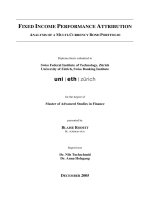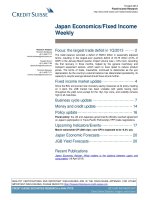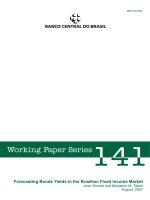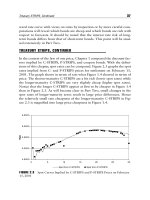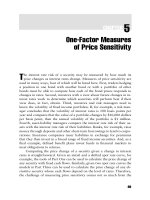Fixed income analysis workbook
Bạn đang xem bản rút gọn của tài liệu. Xem và tải ngay bản đầy đủ của tài liệu tại đây (3.25 MB, 169 trang )
CFA Institute is the premier association for investment professionals around the world, with more than 150,000 CFA charterholders worldwide in
®
165+ countries and regions. Since 1963 the organization has developed and administered the renowned Chartered Financial Analyst Program.
With a rich history of leading the investment profession, CFA Institute has set the highest standards in ethics, education, and professional
excellence within the global investment community and is the foremost authority on investment profession conduct and practice. Each book in the
CFA Institute Investment Series is geared toward industry practitioners along with graduate-level finance students and covers the most important
topics in the industry. The authors of these cutting-edge books are themselves industry professionals and academics and bring their wealth of
knowledge and expertise to this series.
FIXED INCOME
ANALYSIS
WORKBOOK
Fourth Edition
James F. Adams, PhD, CFA
Donald J. Smith, PhD
Cover image: Background © maxkrasnov/iStock.com
Cover design: Wiley
Copyright © 2020 by CFA Institute. All rights reserved.
Published by John Wiley & Sons, Inc., Hoboken, New Jersey.
The First, Second, and Third Editions of this book were published by Wiley in 2000, 2011, and 2015, respectively.
Published simultaneously in Canada.
No part of this publication may be reproduced, stored in a retrieval system, or transmitted in any form or by any means, electronic, mechanical,
photocopying, recording, scanning, or otherwise, except as permitted under Section 107 or 108 of the 1976 United States Copyright Act, without
either the prior written permission of the Publisher, or authorization through payment of the appropriate per-copy fee to the Copyright Clearance
Center, Inc., 222 Rosewood Drive, Danvers, MA 01923, (978) 750-8400, fax (978) 646-8600, or on the Web at www.copyright.com. Requests to
the Publisher for permission should be addressed to the Permissions Department, John Wiley & Sons, Inc., 111 River Street, Hoboken, NJ
07030, (201) 748-6011, fax (201) 748-6008, or online at www.wiley.com/go/permissions.
Limit of Liability/Disclaimer of Warranty: While the publisher and author have used their best efforts in preparing this book, they make no
representations or warranties with respect to the accuracy or completeness of the contents of this book and specifically disclaim any implied
warranties of merchantability or fitness for a particular purpose. No warranty may be created or extended by sales representatives or written sales
materials. The advice and strategies contained herein may not be suitable for your situation. You should consult with a professional where
appropriate. Neither the publisher nor author shall be liable for any loss of profit or any other commercial damages, including but not limited to
special, incidental, consequential, or other damages.
For general information on our other products and services or for technical support, please contact our Customer Care Department within the
United States at (800) 762-2974, outside the United States at (317) 572-3993, or fax (317) 572-4002.
Wiley publishes in a variety of print and electronic formats and by print-on-demand. Some material included with standard print versions of this
book may not be included in e-books or in print-on-demand. If this book refers to media such as a CD or DVD that is not included in the version
you purchased, you may download this material at . For more information about Wiley products, visit www.wiley.com.
ISBN 978-1-119-62744-9 (Paper)
ISBN 978-1-119-64687-7 (ePDF)
ISBN 978-1-119-62818-7 (ePub)
CONTENTS
1. Cover
2. Part I Learning Objectives,Summary Overview, and Problems
1. Chapter 1 Fixed-income Securities: Defining Elements
1. Learning Outcomes
2. Summary Overview
3. Problems
2. Chapter 2 Fixed-Income Markets: Issuance, Trading, and Funding
1. Learning Outcomes
2. Summary Overview
3. Problems
3. Chapter 3 Introduction to Fixed-Income Valuation
1. Learning Outcomes
2. Summary Overview
3. Problems
4. Chapter 4 Introduction to Asset-Backed Securities
1. Learning Outcomes
2. Summary Overview
3. Problems
5. Chapter 5 Understanding Fixed Income Risk and Return
1. Learning Outcomes
2. Summary Overview
3. Problems
6. Chapter 6 Fundamentals of Credit Analysis
1. Learning Outcomes
2. Summary Overview
3. Problems
7. Chapter 7 The Term Structure and Interest Rate Dynamics
1. Learning Outcomes
2. Summary Overview
3. Problems
8. Chapter 8 The Arbitrage-Free Valuation Framework
1. Learning Outcomes
2. Summary Overview
3. Problems
9. Chapter 9 Valuation and Analysis of Bonds with Embedded Options
1. Learning Outcomes
2. Summary Overview
3. Problems
10. Chapter 10 Credit Analysis Models
1. Learning Outcomes
2. Summary Overview
3. Problems
4. Note
11. Chapter 11 Credit Default Swaps
1. Learning Outcomes
2. Summary Overview
3. Problems
12. Chapter 12 Overview of Fixed-Income Portfolio Management
1. Learning Outcomes
2. Summary Overview
3. Problems
13. Chapter 13 Liability-Driven and Index-Based Strategies
1. Learning Outcomes
2. Summary Overview
3. Problems
14. Chapter 14 Yield Curve Strategies
1. Learning Outcomes
2. Summary Overview
3. Problems
15. Chapter 15 Fixed-Income Active Management: Credit Strategies
1. Learning Outcomes
2. Summary Overview
3. Problems
3. Part II Solutions
1. Chapter 1 Fixed-Income Securities: Defining Elements
1. Solutions
2. Chapter 2 Fixed-Income Markets: Issuance, Trading, and Funding
1. Solutions
3. Chapter 3 Introduction to Fixed-Income Valuation
1. Solutions
4. Chapter 4 Introduction to Asset-Backed Securities
1. Solutions
5. Chapter 5 Understanding Fixed Income Risk and Return
1. Solutions
6. Chapter 6 Fundamentals of Credit Analysis
1. Solutions
7. Chapter 7 The Term Structure and Interest Rate Dynamics
1. Solutions
8. Chapter 8 The Arbitrage-Free Valuation Framework
1. Solutions
9. Chapter 9 Valuation and Analysis of Bonds with Embedded Options
1. Solutions
10. Chapter 10 Credit Analysis Models
1. Solutions
11. Chapter 11 Credit Default Swaps
1. Solutions
12. Chapter 12 Overview of Fixed-Income Portfolio Management
1. Solutions
13. Chapter 13 Liability-Driven and Index-Based Strategies
1. Solutions
14. Chapter 14 Yield Curve Strategies
1. Solutions
15. Chapter 15 Fixed-Income Active Management: Credit Strategies
1. Solutions
4. About the CFA Program
5. End User License Agreement
Guide
1. Cover
2. Table of Contents
3. Part I
Pages
1.
2.
3.
4.
5.
6.
7.
8.
9.
10.
11.
12.
13.
14.
15.
16.
17.
18.
19.
20.
21.
22.
23.
24.
25.
26.
27.
28.
29.
30.
31.
32.
33.
34.
35.
36.
37.
38.
39.
40.
ii
iii
iv
1
3
4
5
6
7
8
9
10
11
12
13
14
15
16
17
18
19
20
21
22
23
24
25
27
28
29
30
31
32
33
34
35
36
37
38
39
41.
42.
43.
44.
45.
46.
47.
48.
49.
50.
51.
52.
53.
54.
55.
56.
57.
58.
59.
60.
61.
62.
63.
64.
65.
66.
67.
68.
69.
70.
71.
72.
73.
74.
75.
76.
77.
78.
79.
80.
81.
82.
83.
84.
85.
86.
87.
88.
89.
90.
91.
92.
93.
94.
95.
96.
97.
98.
99.
100.
101.
102.
103.
104.
105.
106.
107.
108.
109.
110.
111.
112.
113.
114.
115.
116.
40
41
42
43
44
45
46
47
48
49
50
51
52
53
54
55
56
57
58
59
60
61
62
63
64
65
66
67
68
69
70
71
72
73
74
75
77
78
79
80
81
82
83
84
85
86
87
88
89
91
92
93
94
95
96
97
98
99
100
101
102
103
104
105
106
107
108
109
110
111
112
113
115
116
117
118
116.
117.
118.
119.
120.
121.
122.
123.
124.
125.
126.
127.
128.
129.
130.
131.
132.
133.
134.
135.
136.
137.
138.
139.
140.
141.
142.
143.
144.
145.
146.
147.
148.
149.
150.
151.
152.
153.
154.
155.
156.
157.
158.
159.
160.
161.
162.
163.
164.
165.
166.
167.
168.
169.
170.
171.
172.
173.
174.
175.
176.
177.
178.
179.
180.
181.
182.
183.
184.
185.
186.
187.
188.
189.
190.
191.
118
119
120
121
122
123
124
125
126
127
129
130
131
132
133
134
135
136
137
138
139
140
141
142
143
145
146
147
148
149
150
151
153
155
156
157
158
159
160
161
162
163
164
165
166
167
168
169
170
171
172
173
174
175
176
177
178
179
180
181
182
183
184
185
186
187
188
189
190
191
192
193
194
195
196
197
192.
193.
194.
195.
196.
197.
198.
199.
200.
201.
202.
203.
204.
205.
206.
207.
208.
209.
210.
211.
212.
213.
214.
215.
216.
217.
218.
219.
220.
221.
222.
223.
224.
225.
226.
227.
228.
229.
230.
231.
232.
233.
234.
235.
236.
237.
238.
239.
240.
241.
242.
243.
244.
245.
246.
247.
248.
249.
250.
198
199
200
201
202
203
204
205
206
207
208
209
210
211
212
213
214
215
216
217
218
219
220
221
222
223
224
225
226
227
228
229
230
231
232
233
235
236
237
239
240
241
242
243
245
246
247
248
249
250
251
252
253
254
255
257
258
259
260
PART I
LEARNING OBJECTIVES,
SUMMARY OVERVIEW,
AND PROBLEMS
CHAPTER 1
Fixed-income Securities: Defining Elements
Learning Outcomes
After completing this chapter, you will be able to do the following:
describe basic features of a fixed-income security;
describe content of a bond indenture;
compare affirmative and negative covenants and identify examples of each;
describe how legal, regulatory, and tax considerations affect the issuance and trading of fixed-income securities;
describe how cash flows of fixed-income securities are structured;
describe contingency provisions affecting the timing and/or nature of cash flows of fixed-income securities and identify whether such
provisions benefit the borrower or the lender.
Summary Overview
This chapter provides an introduction to the salient features of fixed-income securities while noting how these features vary among different types
of securities. Important points include the following:
The three important elements that an investor needs to know when investing in a fixed-income security are: (1) the bond’s features, which
determine its scheduled cash flows and thus the bondholder’s expected and actual return; (2) the legal, regulatory, and tax considerations
that apply to the contractual agreement between the issuer and the bondholders; and (3) the contingency provisions that may affect the
bond’s scheduled cash flows.
The basic features of a bond include the issuer, maturity, par value (or principal), coupon rate and frequency, and currency denomination.
Issuers of bonds include supranational organizations, sovereign governments, non-sovereign governments, quasi-government entities, and
corporate issuers.
Bondholders are exposed to credit risk and may use bond credit ratings to assess the credit quality of a bond.
A bond’s principal is the amount the issuer agrees to pay the bondholder when the bond matures.
The coupon rate is the interest rate that the issuer agrees to pay to the bondholder each year. The coupon rate can be a fixed rate or a
floating rate. Bonds may offer annual, semi-annual, quarterly, or monthly coupon payments depending on the type of bond and where the
bond is issued.
Bonds can be issued in any currency. Bonds such as dual-currency bonds and currency option bonds are connected to two currencies.
The yield to maturity is the discount rate that equates the present value of the bond’s future cash flows until maturity to its price. Yield to
maturity can be considered an estimate of the market’s expectation for the bond’s return.
A plain vanilla bond has a known cash flow pattern. It has a fixed maturity date and pays a fixed rate of interest over the bond’s life.
The bond indenture or trust deed is the legal contract that describes the form of the bond, the issuer’s obligations, and the investor’s rights.
The indenture is usually held by a financial institution called a trustee, which performs various duties specified in the indenture.
The issuer is identified in the indenture by its legal name and is obligated to make timely payments of interest and repayment of principal.
For asset-backed securities, the legal obligation to repay bondholders often lies with a separate legal entity—that is, a bankruptcy-remote
vehicle that uses the assets as guarantees to back a bond issue.
How the issuer intends to service the debt and repay the principal should be described in the indenture. The source of repayment proceeds
varies depending on the type of bond.
Collateral backing is a way to alleviate credit risk. Secured bonds are backed by assets or financial guarantees pledged to ensure debt
payment. Examples of collateral-backed bonds include collateral trust bonds, equipment trust certificates, mortgage-backed securities, and
covered bonds.
Credit enhancement can be internal or external. Examples of internal credit enhancement include subordination, overcollateralization, and
reserve accounts. A bank guarantee, a surety bond, a letter of credit, and a cash collateral account are examples of external credit
enhancement.
Bond covenants are legally enforceable rules that borrowers and lenders agree on at the time of a new bond issue. Affirmative covenants
enumerate what issuers are required to do, whereas negative covenants enumerate what issuers are prohibited from doing.
An important consideration for investors is where the bonds are issued and traded, because it affects the laws, regulation, and tax status
that apply. Bonds issued in a particular country in local currency are domestic bonds if they are issued by entities incorporated in the country
and foreign bonds if they are issued by entities incorporated in another country. Eurobonds are issued internationally, outside the
jurisdiction of any single country, and are subject to a lower level of listing, disclosure, and regulatory requirements than domestic or foreign
bonds. Global bonds are issued in the Eurobond market and at least one domestic market at the same time.
Although some bonds may offer special tax advantages, as a general rule, interest is taxed at the ordinary income tax rate. Some countries
also implement a capital gains tax. There may be specific tax provisions for bonds issued at a discount or bought at a premium.
An amortizing bond is a bond whose payment schedule requires periodic payment of interest and repayment of principal. This differs from a
bullet bond, whose entire payment of principal occurs at maturity. The amortizing bond’s outstanding principal amount is reduced to zero by
the maturity date for a fully amortized bond, but a balloon payment is required at maturity to retire the bond’s outstanding principal amount
for a partially amortized bond.
Sinking fund agreements provide another approach to the periodic retirement of principal, in which an amount of the bond’s principal
outstanding amount is usually repaid each year throughout the bond’s life or after a specified date.
A floating-rate note, or floater, is a bond whose coupon is set based on some reference rate plus a spread. FRNs can be floored, capped,
or collared. An inverse FRN is a bond whose coupon has an inverse relationship to the reference rate.
Other coupon payment structures include bonds with step-up coupons, which pay coupons that increase by specified amounts on specified
dates; bonds with credit-linked coupons, which change when the issuer’s credit rating changes; bonds with payment-in-kind coupons that
allow the issuer to pay coupons with additional amounts of the bond issue rather than in cash; and bonds with deferred coupons, which pay
no coupons in the early years following the issue but higher coupons thereafter.
The payment structures for index-linked bonds vary considerably among countries. A common index-linked bond is an inflation-linked bond,
or linker, whose coupon payments and/or principal repayments are linked to a price index. Index-linked payment structures include zerocoupon-indexed bonds, interest-indexed bonds, capital-indexed bonds, and indexed-annuity bonds.
Common types of bonds with embedded options include callable bonds, putable bonds, and convertible bonds. These options are
“embedded” in the sense that there are provisions provided in the indenture that grant either the issuer or the bondholder certain rights
affecting the disposal or redemption of the bond. They are not separately traded securities.
Callable bonds give the issuer the right to buy bonds back prior to maturity, thereby raising the reinvestment risk for the bondholder. For this
reason, callable bonds have to offer a higher yield and sell at a lower price than otherwise similar non-callable bonds to compensate the
bondholders for the value of the call option to the issuer.
Putable bonds give the bondholder the right to sell bonds back to the issuer prior to maturity. Putable bonds offer a lower yield and sell at a
higher price than otherwise similar non-putable bonds to compensate the issuer for the value of the put option to the bondholders.
A convertible bond gives the bondholder the right to convert the bond into common shares of the issuing company. Because this option
favors the bondholder, convertible bonds offer a lower yield and sell at a higher price than otherwise similar non-convertible bonds.
Problems
1. A 10-year bond was issued four years ago. The bond is denominated in US dollars, offers a coupon rate of 10% with interest paid semiannually, and is currently priced at 102% of par. The bond’s:
1. tenor is six years.
2. nominal rate is 5%.
3. redemption value is 102% of the par value.
2. A sovereign bond has a maturity of 15 years. The bond is best described as a:
1. perpetual bond.
2. pure discount bond.
3. capital market security.
3. A company has issued a floating-rate note with a coupon rate equal to the three-month Libor + 65 basis points. Interest payments are made
quarterly on 31 March, 30 June, 30 September, and 31 December. On 31 March and 30 June, the three-month Libor is 1.55% and 1.35%,
respectively. The coupon rate for the interest payment made on 30 June is:
1. 2.00%.
2. 2.10%.
3. 2.20%.
4. The legal contract that describes the form of the bond, the obligations of the issuer, and the rights of the bondholders can be best described
as a bond’s:
1. covenant.
2. indenture.
3. debenture.
5. Which of the following is a type of external credit enhancement?
1. Covenants
2. A surety bond
3. Overcollaterization
6. An affirmative covenant is most likely to stipulate:
1. limits on the issuer’s leverage ratio.
2. how the proceeds of the bond issue will be used.
3. the maximum percentage of the issuer’s gross assets that can be sold.
7. Which of the following best describes a negative bond covenant? The issuer is:
1. required to pay taxes as they come due.
2. prohibited from investing in risky projects.
3. required to maintain its current lines of business.
8. A South African company issues bonds denominated in pound sterling that are sold to investors in the United Kingdom. These bonds can
be best described as:
1. Eurobonds.
2. global bonds.
3. foreign bonds.
9. Relative to domestic and foreign bonds, Eurobonds are most likely to be:
1. bearer bonds.
2. registered bonds.
3. subject to greater regulation.
10. An investor in a country with an original issue discount tax provision purchases a 20-year zero-coupon bond at a deep discount to par value.
The investor plans to hold the bond until the maturity date. The investor will most likely report:
1. a capital gain at maturity.
2. a tax deduction in the year the bond is purchased.
3. taxable income from the bond every year until maturity.
11. A bond that is characterized by a fixed periodic payment schedule that reduces the bond’s outstanding principal amount to zero by the
maturity date is best described as a:
1. bullet bond.
2. plain vanilla bond.
3. fully amortized bond.
12. If interest rates are expected to increase, the coupon payment structure most likely to benefit the issuer is a:
1. step-up coupon.
2. inflation-linked coupon.
3. cap in a floating-rate note.
13. Investors who believe that interest rates will rise most likely prefer to invest in:
1. inverse floaters.
2. fixed-rate bonds.
3. floating-rate notes.
14. A 10-year, capital-indexed bond linked to the Consumer Price Index (CPI) is issued with a coupon rate of 6% and a par value of 1,000. The
bond pays interest semi-annually. During the first six months after the bond’s issuance, the CPI increases by 2%. On the first coupon
payment date, the bond’s:
1. coupon rate increases to 8%.
2. coupon payment is equal to 40.
3. principal amount increases to 1,020.
15. The provision that provides bondholders the right to sell the bond back to the issuer at a predetermined price prior to the bond’s maturity
date is referred to as:
1. a put provision.
2. a make-whole call provision.
3. an original issue discount provision.
16. Which of the following provisions is a benefit to the issuer?
1. Put provision
2. Call provision
3. Conversion provision
17. Relative to an otherwise similar option-free bond, a:
1. putable bond will trade at a higher price.
2. callable bond will trade at a higher price.
3. convertible bond will trade at a lower price.
18. Which type of bond most likely earns interest on an implied basis?
1. Floater
2. Conventional bond
3. Pure discount bond
19. Clauses that specify the rights of the bondholders and any actions that the issuer is obligated to perform or is prohibited from performing
are:
1. covenants.
2. collaterals.
3. credit enhancements.
20. Which of the following type of debt obligation most likely protects bondholders when the assets serving as collateral are non-performing?
1. Covered bonds
2. Collateral trust bonds
3. Mortgage-backed securities
21. Which of the following best describes a negative bond covenant? The requirement to:
1. insure and maintain assets.
2. comply with all laws and regulations.
3. maintain a minimum interest coverage ratio.
22. Contrary to positive bond covenant, negative covenants are most likely:
1. costlier.
2. legally enforceable.
3. enacted at time of issue.
23. A five-year bond has the following cash flows:
The bond can best be described as a:
1. bullet bond.
2. fully amortized bond.
3. partially amortized bond.
24. Investors seeking some general protection against a poor economy are most likely to select a:
1. deferred coupon bond.
2. credit-linked coupon bond.
3. payment-in-kind coupon bond.
25. The benefit to the issuer of a deferred coupon bond is most likely related to:
1. tax management.
2. cash flow management.
3. original issue discount price.
26. Which of the following bond types provides the most benefit to a bondholder when bond prices are declining?
1. Callable
2. Plain vanilla
3. Multiple put
27. Which type of call bond option offers the greatest flexibility as to when the issuer can exercise the option?
1. A Bermuda call
2. A European call
3. An American call
28. Which of the following best describes a convertible bond’s conversion premium?
1. Bond price minus conversion value
2. Par value divided by conversion price
3. Current share price multiplied by conversion ratio
CHAPTER 2
Fixed-Income Markets: Issuance, Trading, and Funding
Learning Outcomes
After completing this chapter, you will be able to do the following:
describe classifications of global fixed-income markets;
describe the use of interbank offered rates as reference rates in floating-rate debt;
describe mechanisms available for issuing bonds in primary markets;
describe secondary markets for bonds;
describe securities issued by sovereign governments;
describe securities issued by non-sovereign governments, quasi-government entities, and supranational agencies;
describe types of debt issued by corporations;
describe structured financial instruments;
describe short-term funding alternatives available to banks;
describe repurchase agreements (repos) and the risks associated with them.
Summary Overview
Debt financing is an important source of funds for households, governments, government-related entities, financial institutions, and non-financial
companies. Well-functioning fixed-income markets help ensure that capital is allocated efficiently to its highest and best use globally. Important
points include the following:
The most widely used ways of classifying fixed-income markets include the type of issuer; the bonds’ credit quality, maturity, currency
denomination, and type of coupon; and where the bonds are issued and traded.
Based on the type of issuer, the four major bond market sectors are the household, non-financial corporate, government, and financial
institution sectors.
Investors make a distinction between investment-grade and high-yield bond markets based on the issuer’s credit quality.
Money markets are where securities with original maturities ranging from overnight to one year are issued and traded, whereas capital
markets are where securities with original maturities longer than one year are issued and traded.
The majority of bonds are denominated in either euros or US dollars.
Investors make a distinction between bonds that pay a fixed rate versus a floating rate of interest. The coupon rate of floating-rate bonds is
often expressed as a reference rate plus a spread. Interbank offered rates, such as Libor, historically have been the most commonly used
reference rates for floating-rate debt and other financial instruments but are being phased out to be replaced by alternative reference rates.
Based on where the bonds are issued and traded, a distinction is made between domestic and international bond markets. The latter
includes the Eurobond market, which falls outside the jurisdiction of any single country and is characterized by less reporting, regulatory, and
tax constraints. Investors also make a distinction between developed and emerging bond markets.
Fixed-income indexes are used by investors and investment managers to describe bond markets or sectors and to evaluate performance
of investments and investment managers.
The largest investors in bonds include central banks; institutional investors, such as pension funds, hedge funds, charitable foundations and
endowments, insurance companies, mutual funds and ETFs, and banks; and retail investors, typically by means of indirect investments.
Primary markets are markets in which issuers first sell bonds to investors to raise capital. Secondary markets are markets in which existing
bonds are subsequently traded among investors.
There are two mechanisms for issuing a bond in primary markets: a public offering, in which any member of the public may buy the bonds,
or a private placement, in which only an investor or small group of investors may buy the bonds either directly from the issuer or through an
investment bank.
Public bond issuing mechanisms include underwritten offerings, best effort offerings, shelf registrations, and auctions.
When an investment bank underwrites a bond issue, it buys the entire issue and takes the risk of reselling it to investors or dealers. In
contrast, in a best-efforts offering, the investment bank serves only as a broker and sells the bond issue only if it is able to do so.
Underwritten and best effort offerings are frequently used in the issuance of corporate bonds.
The underwriting process typically includes six phases: the determination of the funding needs, the selection of the underwriter, the
structuring and announcement of the bond offering, pricing, issuance, and closing.
A shelf registration is a method for issuing securities in which the issuer files a single document with regulators that describes and allows for
a range of future issuances.
An auction is a public offering method that involves bidding, and that is helpful in providing price discovery and in allocating securities. It is
frequently used in the issuance of sovereign bonds.
Most bonds are traded in over-the-counter (OTC) markets, and institutional investors are the major buyers and sellers of bonds in secondary
markets.
Sovereign bonds are issued by national governments primarily for fiscal reasons. They take different names and forms depending on where
they are issued, their maturities, and their coupon types. Most sovereign bonds are fixed-rate bonds, although some national governments
also issue floating-rate bonds and inflation-linked bonds.
Local governments, quasi-government entities, and supranational agencies issue bonds, which are named non-sovereign, quasigovernment, and supranational bonds, respectively.
Companies raise debt in the form of bilateral loans, syndicated loans, commercial paper, notes, and bonds.
Commercial paper is a short-term unsecured security that is used by companies as a source of short-term and bridge financing. Investors in
commercial paper are exposed to credit risk, although defaults are rare. Many issuers roll over their commercial paper on a regular basis.
Corporate bonds and notes take different forms depending on the maturities, coupon payment, and principal repayment structures.
Important considerations also include collateral backing and contingency provisions.
Medium-term notes are securities that are offered continuously to investors by an agent of the issuer. They can have short-term or long-term
maturities.
The structured finance sector includes asset-backed securities, collateralized debt obligations, and other structured financial instruments.
All of these seemingly disparate financial instruments share the common attribute of repackaging risks.
Many structured financial instruments are customized instruments that often combine a bond and at least one derivative. The redemption
and often the coupons of these structured financial instruments are linked via a formula to the performance of the underlying asset(s). Thus,
the bond’s payment features are replaced with non-traditional payoffs that are derived not from the issuer’s cash flows but from the
performance of the underlying asset(s). Capital protected, yield enhancement, participation, and leveraged instruments are typical
examples of structured financial instruments.
Financial institutions have access to additional sources of funds, such as retail deposits, central bank funds, interbank funds, largedenomination negotiable certificates of deposit, and repurchase agreements.
A repurchase agreement is similar to a collateralized loan. It involves the sale of a security (the collateral) with a simultaneous agreement by
the seller (the borrower) to buy the same security back from the purchaser (the lender) at an agreed-on price in the future. Repurchase
agreements are a common source of funding for dealer firms and are also used to borrow securities to implement short positions.
Problems
1. In most countries, the bond market sector with the smallest amount of bonds outstanding is most likely the:
1. government sector.
2. financial corporate sector.
3. non-financial corporate sector.
2. The distinction between investment grade debt and non-investment grade debt is best described by differences in:
1. tax status.
2. credit quality.
3. maturity dates.
3. A bond issued internationally, outside the jurisdiction of the country in whose currency the bond is denominated, is best described as a:
1. Eurobond.
2. foreign bond.
3. municipal bond.
4. When classified by type of issuer, asset-backed securities are part of the:
1. corporate sector.
2. structured finance sector.
3. government and government-related sector.
5. Compared with developed markets bonds, emerging markets bonds most likely:
1. offer lower yields.
2. exhibit higher risk.
3. benefit from lower growth prospects.
6. With respect to floating-rate bonds, a reference rate such as the London interbank offered rate (Libor) is most likely used to determine the
bond’s:
1. spread.
2. coupon rate.
3. frequency of coupon payments.
7. The variability of the coupon rate on a Libor-based floating-rate bond is most likely due to:
1. periodic resets of the reference rate.
2. market-based reassessments of the issuer’s creditworthiness.
3. changing estimates by the Libor administrator of borrowing capacity.
8. Which of the following statements is most accurate? An interbank offered rate:
1. is a single reference rate.
2. applies to borrowing periods of up to 10 years.
3. is used as a reference rate for interest rate swaps.
9. An investment bank that underwrites a bond issue most likely:
1. buys and resells the newly issued bonds to investors or dealers.
2. acts as a broker and receives a commission for selling the bonds to investors.
3. incurs less risk associated with selling the bonds than in a best efforts offering.
10. In major developed bond markets, newly issued sovereign bonds are most often sold to the public via a(n):
1. auction.
2. private placement.
3. best efforts offering.
11. Which of the following describes privately placed bonds?
1. They are non-underwritten and unregistered.
2. They usually have active secondary markets.
3. They are less customized than publicly offered bonds.
12. A mechanism by which an issuer may be able to offer additional bonds to the general public without preparing a new and separate offering
circular best describes:
1. the grey market.
2. a shelf registration.
3. a private placement.
13. Which of the following statements related to secondary bond markets is most accurate?
1. Newly issued corporate bonds are issued in secondary bond markets.
2. Secondary bond markets are where bonds are traded between investors.
3. The major participants in secondary bond markets globally are retail investors.
14. A bond market in which a communications network matches buy and sell orders initiated from various locations is best described as an:
1. organized exchange.
2. open market operation.
3. over-the-counter market.
15. A liquid secondary bond market allows an investor to sell a bond at:
1. the desired price.
2. a price at least equal to the purchase price.
3. a price close to the bond’s fair market value.
16. Corporate bond secondary market trading most often occurs:
1. on a book-entry basis.
2. on organized exchanges.
3. prior to settlement at T + 1.
17. Sovereign bonds are best described as:
1. bonds issued by local governments.
2. secured obligations of a national government.
3. bonds backed by the taxing authority of a national government.
18. Which factor is associated with a more favorable quality sovereign bond credit rating?
1. Issued in local currency, only
2. Strong domestic savings base, only
3. Issued in local currency of country with strong domestic savings base
19. Which type of sovereign bond has the lowest interest rate risk for an investor?
1. Floaters
2. Coupon bonds
3. Discount bonds
20. Agency bonds are issued by:
1. local governments.
2. national governments.
3. quasi-government entities.
21. The type of bond issued by a multilateral agency such as the International Monetary Fund (IMF) is best described as a:
1. sovereign bond.
2. supranational bond.
3. quasi-government bond.
22. A bond issued by a local government authority, typically without an explicit funding commitment from the national government, is most likely
classified as a:
1. sovereign bond.
2. quasi-government bond
3. non-sovereign government bond.
23. Which of the following statements relating to commercial paper is most accurate?
1. There is no secondary market for trading commercial paper.
2. Only the strongest, highly rated companies issue commercial paper.
3. Commercial paper is a source of interim financing for long-term projects.
24. Eurocommerical paper is most likely:
1. negotiable.
2. denominated in euro.
3. issued on a discount basis.
25. For the issuer, a sinking fund arrangement is most similar to a:
1. term maturity structure.
2. serial maturity structure.
3. bondholder put provision.
26. When issuing debt, a company may use a sinking fund arrangement as a means of reducing:
1. credit risk.
2. inflation risk.
3. interest rate risk.
27. Which of the following is a source of wholesale funds for banks?
1. Demand deposits
2. Money market accounts
3. Negotiable certificates of deposit
28. A characteristic of negotiable certificates of deposit is:
1. they are mostly available in small denominations.
2. they can be sold in the open market prior to maturity.
3. a penalty is imposed if the depositor withdraws funds prior to maturity.
29. A repurchase agreement is most comparable to a(n):
1. interbank deposit.
2. collateralized loan.
3. negotiable certificate of deposit.
30. The repo margin is:
1. negotiated between counterparties.
2. established independently of market-related conditions.
3. structured on an agreement assuming equal credit risks to all counterparties.
31. The repo margin on a repurchase agreement is most likely to be lower when:
1. the underlying collateral is in short supply.
2. the maturity of the repurchase agreement is long.
3. the credit risk associated with the underlying collateral is high.
CHAPTER 3
Introduction to Fixed-Income Valuation
Learning Outcomes
After completing this chapter, you will be able to do the following:
calculate a bond’s price given a market discount rate;
identify the relationships among a bond’s price, coupon rate, maturity, and market discount rate (yield-to-maturity);
define spot rates and calculate the price of a bond using spot rates;
describe and calculate the flat price, accrued interest, and the full price of a bond;
describe matrix pricing;
calculate annual yield on a bond for varying compounding periods in a year;
calculate and interpret yield measures for fixed-rate bonds and floating-rate notes;
calculate and interpret yield measures for money market instruments;
define and compare the spot curve, yield curve on coupon bonds, par curve, and forward curve;
define forward rates and calculate spot rates from forward rates, forward rates from spot rates, and the price of a bond using forward rates;
compare, calculate, and interpret yield spread measures.
Summary Overview
This chapter covers the principles and techniques that are used in the valuation of fixed-rate bonds, as well as floating-rate notes and money
market instruments. These building blocks are used extensively in fixed income analysis. The following are the main points made in the chapter:
The market discount rate is the rate of return required by investors given the risk of the investment in the bond.
A bond is priced at a premium above par value when the coupon rate is greater than the market discount rate.
A bond is priced at a discount below par value when the coupon rate is less than the market discount rate.
The amount of any premium or discount is the present value of the “excess” or “deficiency” in the coupon payments relative to the yield-tomaturity.
The yield-to-maturity, the internal rate of return on the cash flows, is the implied market discount rate given the price of the bond.
A bond price moves inversely with its market discount rate.
The relationship between a bond price and its market discount rate is convex.
The price of a lower-coupon bond is more volatile than the price of a higher-coupon bond, other things being equal.
Generally, the price of a longer-term bond is more volatile than the price of shorter-term bond, other things being equal. An exception to this
phenomenon can occur on low-coupon (but not zero-coupon) bonds that are priced at a discount to par value.
Assuming no default, premium and discount bond prices are “pulled to par” as maturity nears.
A spot rate is the yield-to-maturity on a zero-coupon bond.
A yield-to-maturity can be approximated as a weighted average of the underlying spot rates.
Between coupon dates, the full (or invoice, or “dirty”) price of a bond is split between the flat (or quoted, or “clean”) price and the accrued
interest.
Flat prices are quoted to not misrepresent the daily increase in the full price as a result of interest accruals.
Accrued interest is calculated as a proportional share of the next coupon payment using either the actual/actual or 30/360 methods to count
days.
Matrix pricing is used to value illiquid bonds by using prices and yields on comparable securities having the same or similar credit risk,
coupon rate, and maturity.
The periodicity of an annual interest rate is the number of periods in the year.
A yield quoted on a semi-annual bond basis is an annual rate for a periodicity of two. It is the yield per semi-annual period times two.
The general rule for periodicity conversions is that compounding more frequently at a lower annual rate corresponds to compounding less
frequently at a higher annual rate.
Street convention yields assume payments are made on scheduled dates, neglecting weekends and holidays.
The current yield is the annual coupon payment divided by the flat price, thereby neglecting as a measure of the investor’s rate of return the
time value of money, any accrued interest, and the gain from buying at a discount and the loss from buying at a premium.
The simple yield is like the current yield but includes the straight-line amortization of the discount or premium.
The yield-to-worst on a callable bond is the lowest of the yield-to-first-call, yield-to-second-call, and so on, calculated using the call price for
the future value and the call date for the number of periods.
The option-adjusted yield on a callable bond is the yield-to-maturity after adding the theoretical value of the call option to the price.
A floating-rate note (floater, or FRN) maintains a more stable price than a fixed-rate note because interest payments adjust for changes in
market interest rates.
The quoted margin on a floater is typically the specified yield spread over or under the reference rate, which often is Libor.
The discount margin on a floater is the spread required by investors, and to which the quoted margin must be set, for the FRN to trade at
par value on a rate reset date.
Money market instruments, having one year or less time-to-maturity, are quoted on a discount rate or add-on rate basis.
Money market discount rates understate the investor’s rate of return (and the borrower’s cost of funds) because the interest income is
divided by the face value or the total amount redeemed at maturity, not by the amount of the investment.
Money market instruments need to be converted to a common basis for analysis.
A money market bond equivalent yield is an add-on rate for a 365-day year.
The periodicity of a money market instrument is the number of days in the year divided by the number of days to maturity. Therefore, money
market instruments with different times-to-maturity have annual rates for different periodicities.
In theory, the maturity structure, or term structure, of interest rates is the relationship between yields-to-maturity and times-to-maturity on
bonds having the same currency, credit risk, liquidity, tax status, and periodicity.
A spot curve is a series of yields-to-maturity on zero-coupon bonds.
A frequently used yield curve is a series of yields-to-maturity on coupon bonds.
A par curve is a series of yields-to-maturity assuming the bonds are priced at par value.
In a cash market, the delivery of the security and cash payment is made on a settlement date within a customary time period after the trade
date—for example, “T + 3.”
In a forward market, the delivery of the security and cash payment is made on a predetermined future date.
A forward rate is the interest rate on a bond or money market instrument traded in a forward market.
An implied forward rate (or forward yield) is the breakeven reinvestment rate linking the return on an investment in a shorter-term zerocoupon bond to the return on an investment in a longer-term zero-coupon bond.
An implied forward curve can be calculated from the spot curve.
Implied spot rates can be calculated as geometric averages of forward rates.
A fixed-income bond can be valued using a market discount rate, a series of spot rates, or a series of forward rates.
A bond yield-to-maturity can be separated into a benchmark and a spread.
Changes in benchmark rates capture macroeconomic factors that affect all bonds in the market—inflation, economic growth, foreign
exchange rates, and monetary and fiscal policy.
Changes in spreads typically capture microeconomic factors that affect the particular bond—credit risk, liquidity, and tax effects.
Benchmark rates are usually yields-to-maturity on government bonds or fixed rates on interest rate swaps.
A G-spread is the spread over or under a government bond rate, and an I-spread is the spread over or under an interest rate swap rate.
A G-spread or an I-spread can be based on a specific benchmark rate or on a rate interpolated from the benchmark yield curve.
A Z-spread (zero-volatility spread) is based on the entire benchmark spot curve. It is the constant spread that is added to each spot rate
such that the present value of the cash flows matches the price of the bond.
An option-adjusted spread (OAS) on a callable bond is the Z-spread minus the theoretical value of the embedded call option.
Problems
1. A portfolio manager is considering the purchase of a bond with a 5.5% coupon rate that pays interest annually and matures in three years. If
the required rate of return on the bond is 5%, the price of the bond per 100 of par value is closest to:
1. 98.65.
2. 101.36.
3. 106.43.
2. A bond with two years remaining until maturity offers a 3% coupon rate with interest paid annually. At a market discount rate of 4%, the price
of this bond per 100 of par value is closest to:
1. 95.34.
2. 98.00.
3. 98.11.
3. An investor who owns a bond with a 9% coupon rate that pays interest semi-annually and matures in three years is considering its sale. If
the required rate of return on the bond is 11%, the price of the bond per 100 of par value is closest to:
1. 95.00.
2. 95.11.
3. 105.15.
4. A bond offers an annual coupon rate of 4%, with interest paid semi-annually. The bond matures in two years. At a market discount rate of
6%, the price of this bond per 100 of par value is closest to:
1. 93.07.
2. 96.28.
3. 96.33.
5. A bond offers an annual coupon rate of 5%, with interest paid semi-annually. The bond matures in seven years. At a market discount rate of
3%, the price of this bond per 100 of par value is closest to:
1. 106.60.
2. 112.54.
3. 143.90.
6. A zero-coupon bond matures in 15 years. At a market discount rate of 4.5% per year and assuming annual compounding, the price of the
bond per 100 of par value is closest to:
1. 51.30.
2. 51.67.
3. 71.62.
7. Consider the following two bonds that pay interest annually:
Bond Coupon Rate Time-to-Maturity
A
5%
2 years
B
3%
2 years
At a market discount rate of 4%, the price difference between Bond A and Bond B per 100 of par value is closest to:
1. 3.70.
2. 3.77.
